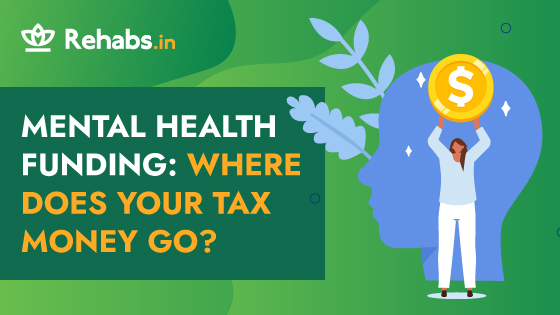Mental Health Funding: Where Does Your Tax Money Go?

Mental health in India is gradually gaining recognition and support, with increasing efforts to reduce stigma and enhance access to services. There are many challenges, such as a significant treatment gap, limited access to mental health services, and enduring stigma surrounding mental illnesses. The country grapples with a shortage of mental health professionals, particularly in rural areas, leading to inadequate support for those in need. Although challenges persist, there is growing awareness about mental health issues, and individuals and organisations are working towards creating a more supportive environment.
In 2015, more people in India took their own lives compared to the average in their region and around the world. For every 100,000 people, 15.7 ended their lives, which is higher than the average in their region (12.9) and the world (10.6). What’s even more concerning is that among people aged 15 to 29 in India, suicide is the main reason for loss of life.
Adequate mental health funding in India is of paramount importance, as it directly impacts the well-being of individuals and society as a whole. Mental health conditions affect millions of people globally, and when left untreated or underfunded, they can lead to suffering, reduced productivity, and a strain on healthcare systems. Proper funding enables the development and maintenance of accessible, high-quality mental health services, including therapy, counselling, and crisis intervention.
Government Initiatives
The Ministry of Health and Family Welfare plays a pivotal role in advancing mental health initiatives in India. As the primary governing body responsible for public health, it is tasked with formulating policies, implementing programs, and allocating resources to address mental health issues. The ministry’s role encompasses creating and updating mental health policies, promoting awareness and reducing stigma around mental health, and ensuring the availability of mental health services across the country.
Budget allocations for mental health in India have historically been insufficient, but there is a growing recognition of the importance of addressing this issue. In recent years, there has been a modest increase in funding for mental health initiatives, reflecting a greater awareness of the need to improve mental healthcare in the country.
In the budget for the year 2023-24, the amount of money given to the Ministry of Health & Family Welfare (MoHFW) has gone up a little by about 3% compared to what they planned for the previous year (₹89,155 crore this year versus ₹86,201 crore last year). If we look at what they actually spent last year (Revised Estimate or RE), this year’s allocation has increased by 13%. The total budget for mental health is estimated to be around 1199 crores.
The Government of India has initiated several policies and programs to address mental health issues in the country. Some of the key policies and programs include:
- National Mental Health Policy, 2014: This policy aims to provide universal access to mental healthcare, promote mental health, and reduce the stigma associated with mental illnesses.
- District Mental Health Program (DMHP): Launched in 1996, this program focuses on providing mental healthcare services at the district level, including the establishment of mental health clinics.
- Rashtriya Bal Swasthya Karyakram (RBSK): Part of the National Health Mission, RBSK includes early identification and management of mental health issues in children and adolescents.
- National Institute of Mental Health and Neurosciences (NIMHANS): NIMHANS, located in Bangalore, is a premier institution dedicated to mental health and neuroscience research, treatment, and training.
- Manas – National Mental Health Information System: This initiative aims to collect and manage data related to mental health services and programs across the country.
Funding Allocations
The amount of money the national government plans to spend in the year 2023–24 is ₹45,03,097 crore, which is 14% more than what they spent in the previous year, 2022–23. The budget allocation in India covers a wide range of sectors, each receiving funding based on its significance and priority for the government. Some of the key sectors for budget allocation in India include:
- Health
- Education
- Agriculture
- Infrastructure
- Defence
- Social Welfare
- Rural Development
- Energy
- Finance and Economy
- Environment and Climate Change
- Transportation
- Science and Technology
- Housing and Urban Development
- Water Resources and Sanitation
- Digital Infrastructure
- Tourism
Some of the major areas of expenditure in the mental health budget are as follows:
- Treatment Facilities and Hospitals: A significant portion of the mental health budget is directed towards establishing and maintaining treatment facilities and hospitals. This allocation ensures that individuals in need have access to quality mental healthcare services, regardless of their location.
- Training and Capacity Building: Investment in training and capacity building is crucial to fostering a skilled workforce of mental health professionals. Funding in this area is used to strengthen postgraduate training departments and establish centres of excellence, ensuring effective care and support.
- Awareness and Education Campaigns: Reducing the stigma surrounding mental health is a top priority. A portion of the budget is dedicated to awareness and education campaigns, which aim to inform the public about mental health issues, encourage early intervention, and promote a more compassionate society.
- Research and Data Collection: Effective policy and program development depend on reliable data. Funding for research and data collection is essential for understanding the prevalence of mental health issues, assessing the effectiveness of interventions, and making informed decisions.
- Medication Subsidies: Access to essential medications is critical. Budget allocation for medication subsidies makes these treatments more affordable and accessible to those in need, helping individuals manage their conditions effectively.
- Rural and Underserved Areas: Recognizing the need to reach underserved regions, the government allocates funds to extend mental health services to rural and remote areas. This includes the expansion of telemedicine services, outreach programs, and the development of mental health infrastructure in remote regions, ensuring equitable access to care.
In the budget of the Ministry of Health and Family Welfare (MoHFW), the money they are giving to two big mental health institutions and a program called National Tele-Mental Health (T-MANAS) has gone up by 16%. Last year, they gave them ₹791 crore, and this year, they’re giving them ₹919 crore. The government is putting more importance on T-MANAS, which is like the digital part of the National Mental Health Program. They’ve even made a special category just for it in the budget. This shows that the government wants to expand and grow digital mental health services.
In the budget of the Ministry of Health and Family Welfare, they have specific parts for mental health funding. They give money to three places: (i) National Institute of Mental Health and Neuro-Sciences (NIMHANS) in Bengaluru, they’re getting ₹721 crore. (ii) Lokpriya Gopinath Bordoloi Regional Institute of Mental Health in Tezpur they’re getting ₹64 crore. (iii) The National Tele-Mental Health Program gets ₹134 crore.
Regional disparities in funding present a significant challenge in the realm of mental health initiatives. In many countries, including India, the allocation of resources for mental healthcare often varies dramatically between urban and rural areas. Urban centres tend to benefit from better-funded facilities, specialised training, and a more comprehensive range of services, while rural and underserved regions often face a shortage of resources and skilled professionals. These disparities not only limit access to care but also perpetuate the burden of mental health issues in marginalised communities.
NGOs and Community Initiatives
- Government support for non-governmental organisations: Many governments around the world, including India, recognise the value of NGOs in mental health initiatives.
- Community-Based Programs: NGOs often operate community-based mental health programs that bridge the gap between formal healthcare services and the communities they serve.
- Impact on Local Mental Health Services: NGO-driven community initiatives have a tangible impact on local mental health services.
Challenges and Future Directions
Funding gaps and resource constraints within India’s mental health budget present significant challenges in addressing the nation’s growing mental health needs. Despite increasing recognition of the importance of mental health, budget allocations have often fallen short of the demand for services and programs. There is a shortage of mental health professionals, insufficient infrastructure, and limited access to care in many regions, particularly in rural areas.
According to Mental Health Statistics, approximately 10.6% of India’s population grapples with mental health conditions, yet a staggering 76-85% of those in need of mental health care remain without services or support. This significant treatment gap is rooted in multiple factors, including the scarcity of trained mental health professionals, a disproportionate concentration of services in urban areas, the absence of community-based care, pervasive stigma, and meagre budgetary allocations for mental health.
Despite the presence of policies like the National Mental Health Policy, India, 2014, and the Mental Healthcare Act, 2017, which aimed to increase funding for mental health and address this gap, it remains a low governance priority. Alarmingly, less than 1% of the country’s overall health budget is earmarked for mental health, leaving a substantial disparity between the need and available resources for mental health services.
Case Studies
The T-MANAS vision entails connecting these new tele-mental health centres with the existing network of local mental health resources in nearby centres of excellence, medical colleges, district hospitals, and other mental health services operated by the central and/or state government.
According to the Union Health Ministry, the Tele-Manas helpline, part of the National Tele Mental Health Programme, has received an impressive 200,000 calls since its launch in October 2022. In just three months, the call volume has doubled. As of July 2023, there are 42 active Tele-Manas cells spanning 31 states and Union Territories. This service now manages more than 1,300 calls daily and is offered in 20 different languages, effectively expanding access to mental health support.
Resources and Support
In India, resources and support for mental health are gradually evolving to meet the growing needs of the population.
Directory of Key Organizations: The country boasts a burgeoning directory of key organisations dedicated to mental health, including government entities like the National Institute of Mental Health and Neuro-Sciences (NIMHANS) and non-governmental organisations such as the Vandrevala Foundation. These organisations play a pivotal role in mental health research, service provision, and advocacy, contributing to the overall ecosystem of support. You can read about more mental health institutions and resources here.
Accessing Mental Health Services: Access to mental health services is improving, with initiatives like the National Tele-Mental Health Programme (T-MANAS) expanding reach through telemedicine and helpline services. This makes it more accessible for individuals, even in remote areas, to seek help and counselling.
Support for Individuals and Families: Various NGOs and community-based programs offer support for individuals and families, reducing the stigma around mental health and providing crucial resources such as counselling, support groups, and educational outreach. These efforts combine to create a more supportive environment for those affected by mental health issues, emphasising the importance of well-being and a stronger, healthier society.
Sources:
Desiraju, K. (2023). Union Budget for Mental Health 2023-2024. In www.cmhlp.org.
IMHO.
PLOS Global Public Health. (2023, May 25). Mind Matters: India’s mental Health budget crisis – Speaking of medicine and health. Speaking of Medicine and Health. https://speakingofmedicine.plos.org/2023/05/25/mind-matters-indias-mental-health-budget-crisis/
Sharma, P. (2023, July 22). Govt’s mental health helpline Tele-Manas receives over 2 lakh calls since launch | Mint. Mint. https://www.livemint.com/news/india/govts-mental-health-helpline-tele-manas-receives-over-2-lakh-calls-since-launch-11690014660473.html
Srivastava, K., Chatterjee, K., & Bhat, P. S. (2016). Mental health awareness: The Indian scenario. Industrial Psychiatry Journal, 25(2), 131. https://doi.org/10.4103/ipj.ipj_45_17














